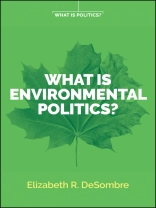Why is it so difficult to control, or fix, pollution? How can we justify harvesting the world’s natural resources at unsustainable rates, even though these activities cause known harm to both people and ecosystems? Scientific knowledge and technological advances alone cannot tackle these environmental challenges; they also involve difficult political choices and trade-offs both locally and globally.
What is Environmental Politics? introduces students to the different ways society attempts to deal with the political decisions needed to prevent or recover from environmental damage. Across its six chapters leading environmental scholar Elizabeth De Sombre explains what makes environmental problems, such as climate change, overfishing or deforestation, particularly challenging to address via political processes, what types of political structures are more or less likely to prioritize protecting the environment, and how effective political intervention can improve environmental conditions and the lives of people who depend on them.
It will be a vital resource for students new to the field of environmental politics as well as readers interested in protecting the future of our planet.
Содержание
Acknowledgements
1. Defining Environmental Politics
2. Uncertainty and Science
3. Political Structures
4. Political Actors
5. International Environmental Politics
6. Engaging with Environmental Politics
Notes
Selected Readings
Index
Об авторе
Elizabeth De Sombre is the Camilla Chandler Frost Professor of Environmental Studies at Wellesley College.












